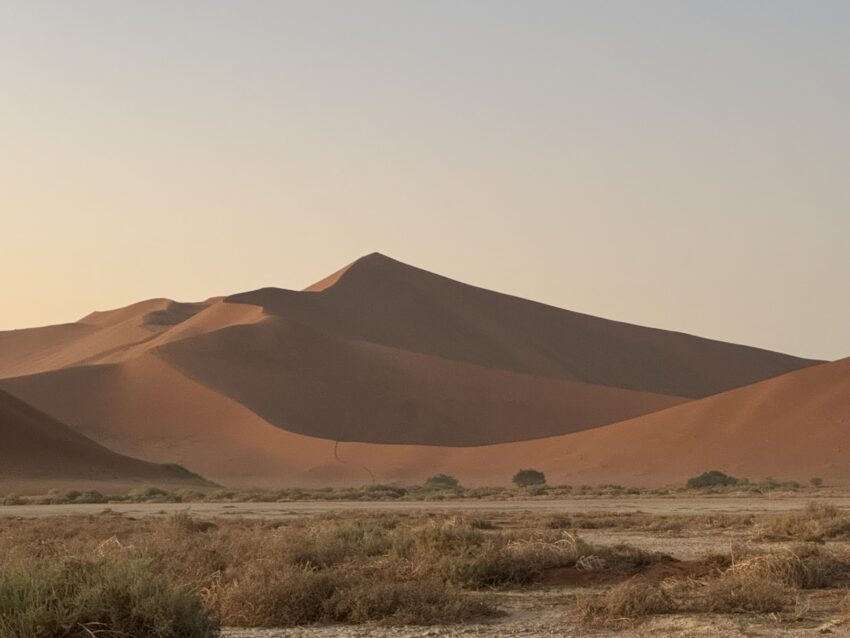5 am comes earlier than any of us hoped. But this should be our last extra-early morning for a while, so we do our best to power through.
There has been much debate regarding breakfast this morning, as we’re leaving well before the Dead Valley Lodge starts serving. The Lodge provides boxed breakfasts for exactly this reason, but it’s difficult to find a boxed breakfast that kids will actually eat. In their defence, boxed breakfasts are usually pretty terrible.
But not this time. With Ewald’s help we make some minor modifications to the breakfasts and end up with something that works – ham and cheese sandwiches, tangerines, yoghurt and muffins.
Into the vehicle for 5:50 am, and into the line to get into the heart of the Sossusvlei National Park. We’re fourth in line, which should make life easier – during peak season there can easily be a hundred cars lined up here. Another reason to stay close to the park.
The Dead Valley lodge isn’t cheap – it’s roughly USD$350 per night per room – but the other options in the park – Wildness and &Beyond – are three or four times as much. So we’re happy to pay Dead Valley’s prices.
We have a forty minute drive into Sossusvlei – thankfully on nice, smooth tarmac. A significant portion of the drives here are on washboard roads, which is fine for short distances but soon becomes punishing. We’re grateful for the reprieve.
We reach the dunes right at sunrise:
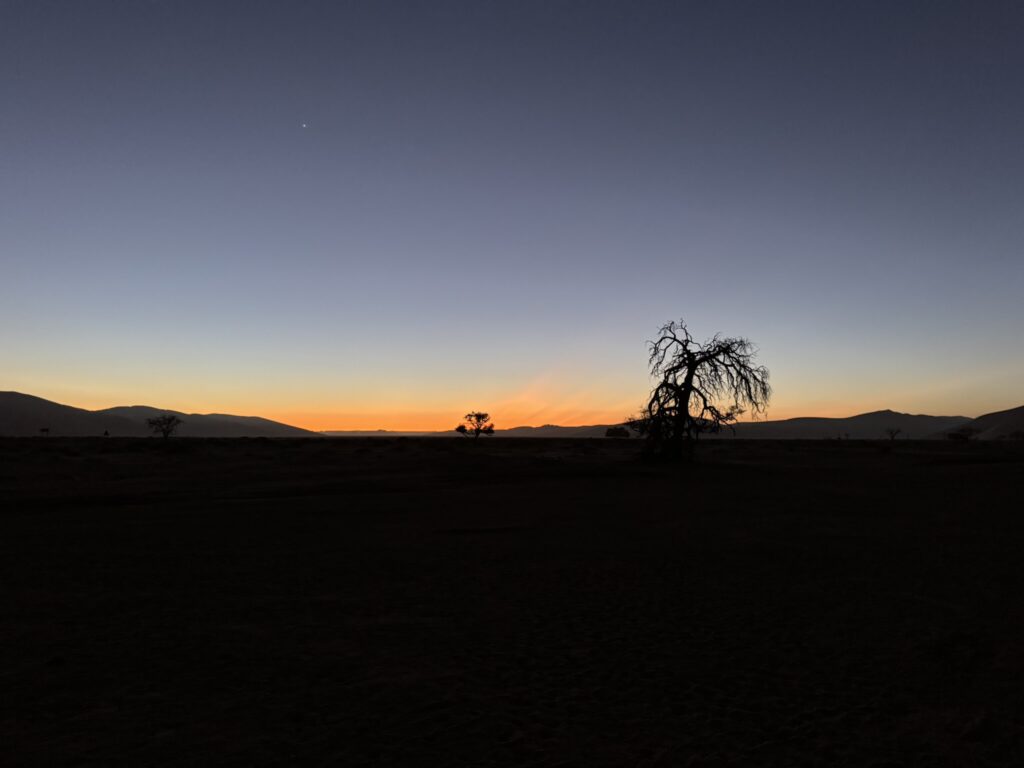
Ewald confirms which dune we want to climb – my son would very much like to climb Big Daddy, the tallest dune in the area and one of the highest in the world at roughly 325 metres in height.
But then Big Daddy comes into view:
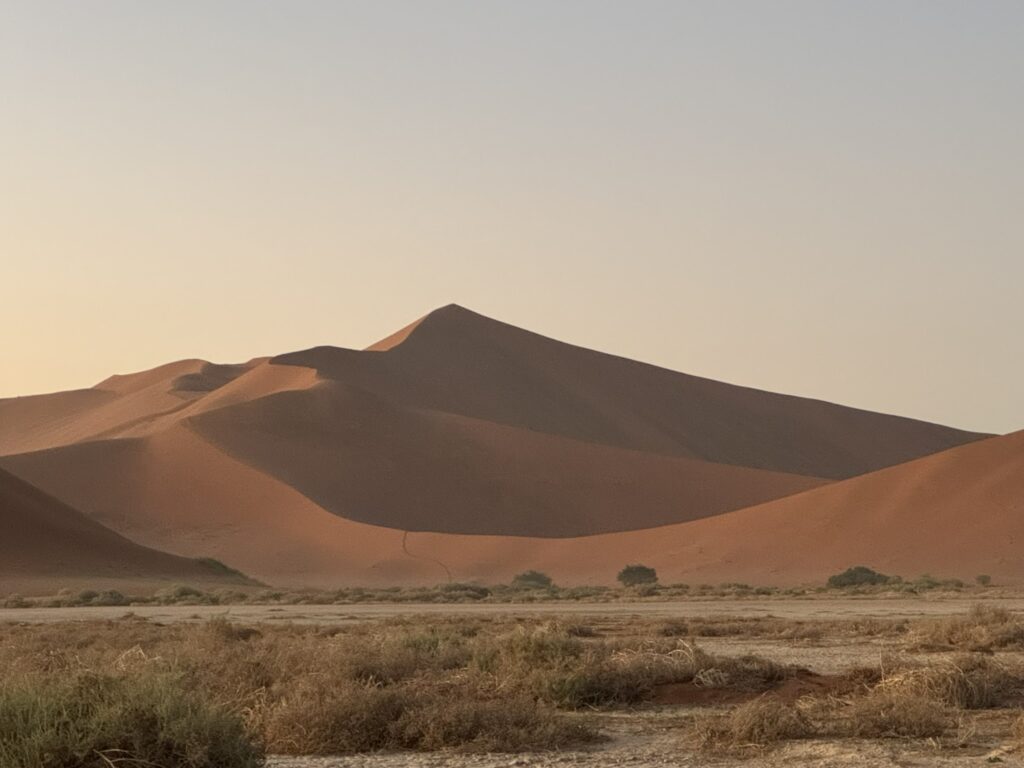
It’s not a straight shot. Nowhere near. We discuss for a while, and then we make the difficult decision to stop after we reach one of the lower peaks. We’re just not prepared to push everyone to the ragged limit – particularly not when we’re tired, and we haven’t been hiking for weeks.
Our son is disappointed, but he understands. Always nice to have a reason to go back.
We discuss the plan with Ewald. There’s a brief moment of confusion as we discuss which dune we go down to get into Deadvlei, as one route apparently leads to the Devil’s Eye instead where people aren’t permitted. Ewald’s going to start out with us along the ridge, and then we’ll meet him down in Deadvlei, which is on the other side.
Ewald also explains the history behind Sossusvlei. It’s believed to be one of the oldest deserts in the world, dating back more than 55 million years. The cold Benguela Current in the Atlantic prevented moisture from travelling inland, while wind and erosion created sand from the sediment of the from the Orange River. The wind then blew the eroded sediment further inland, where it collected in Sossusvlei – which loosely translates to “dead march of no return.”
There are a range of different dune types in the area including star dunes, which are formed by winds from multiple directions. This results in dunes that hardly move, and which can easily exceed 200 metres in height.
We then start to climb. The views are just breathtaking:
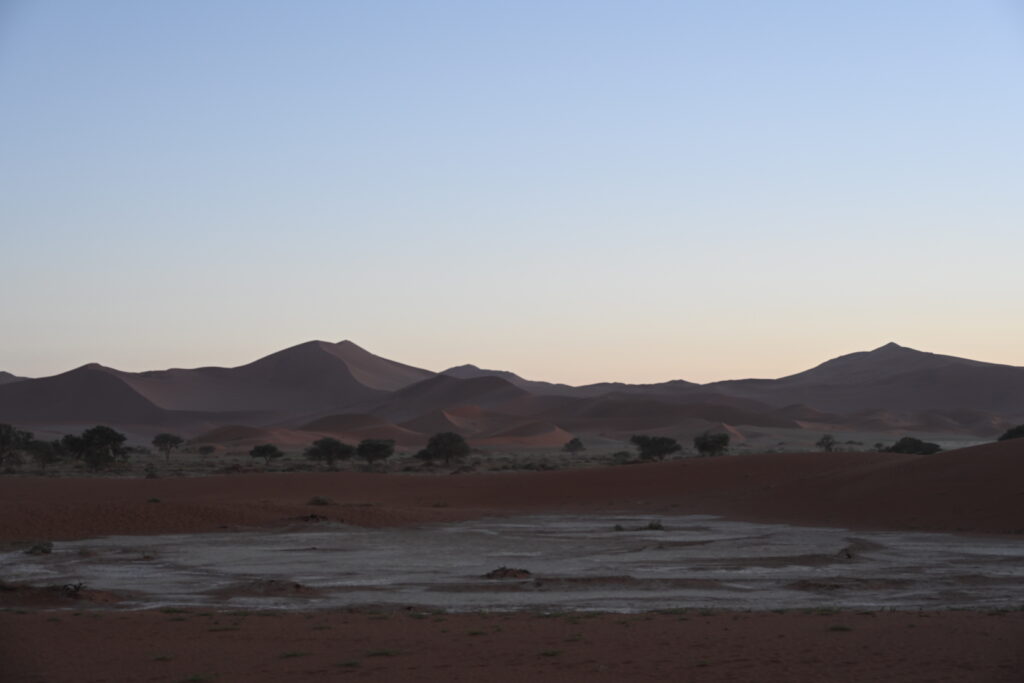
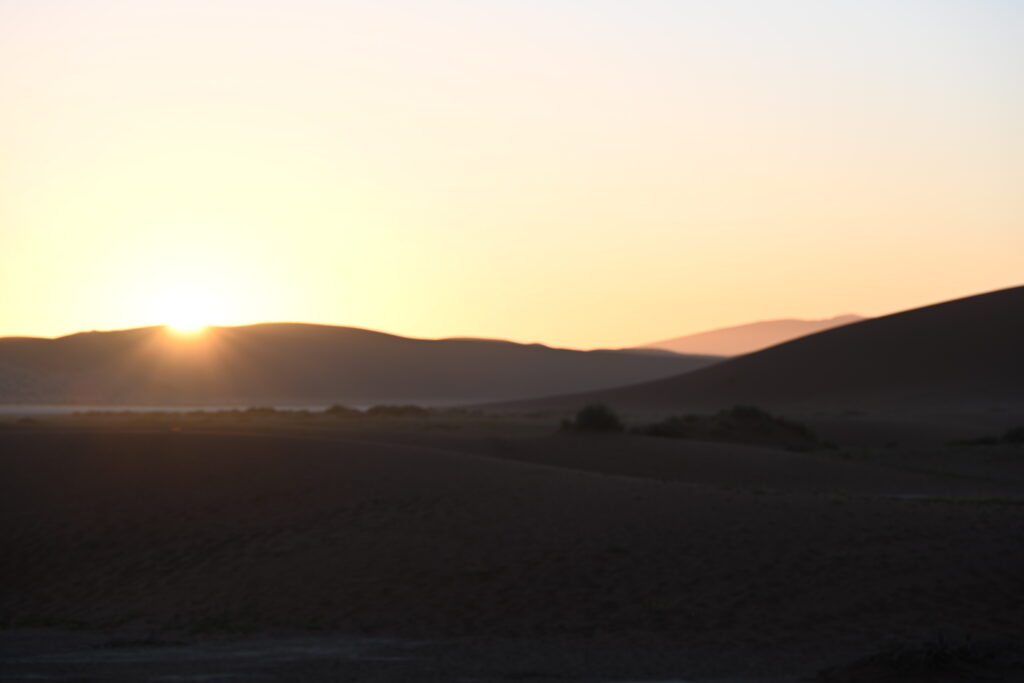
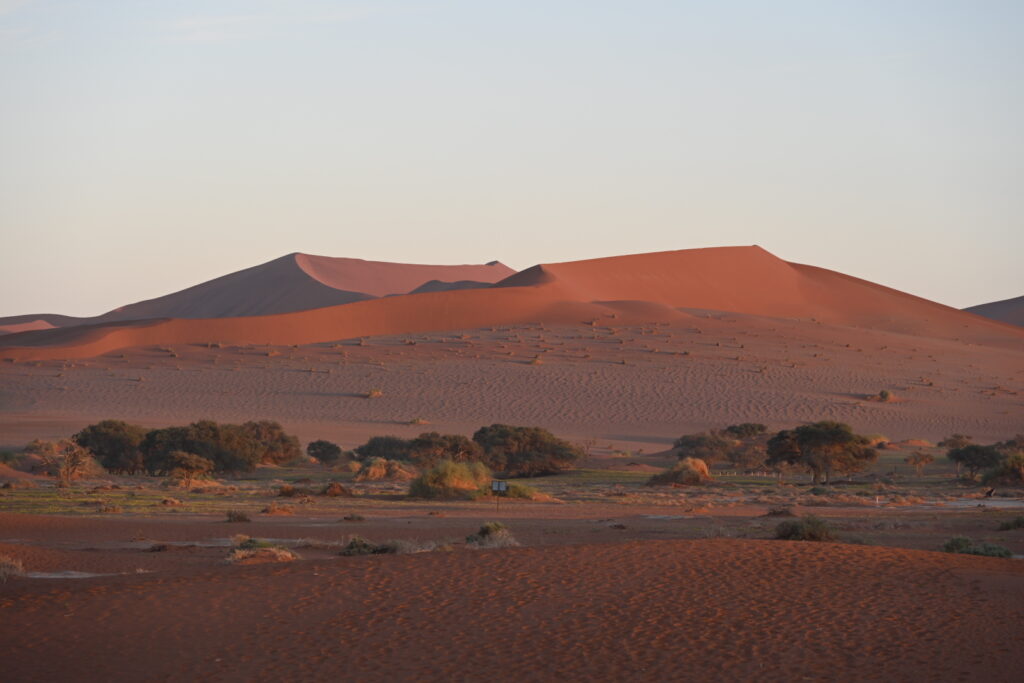
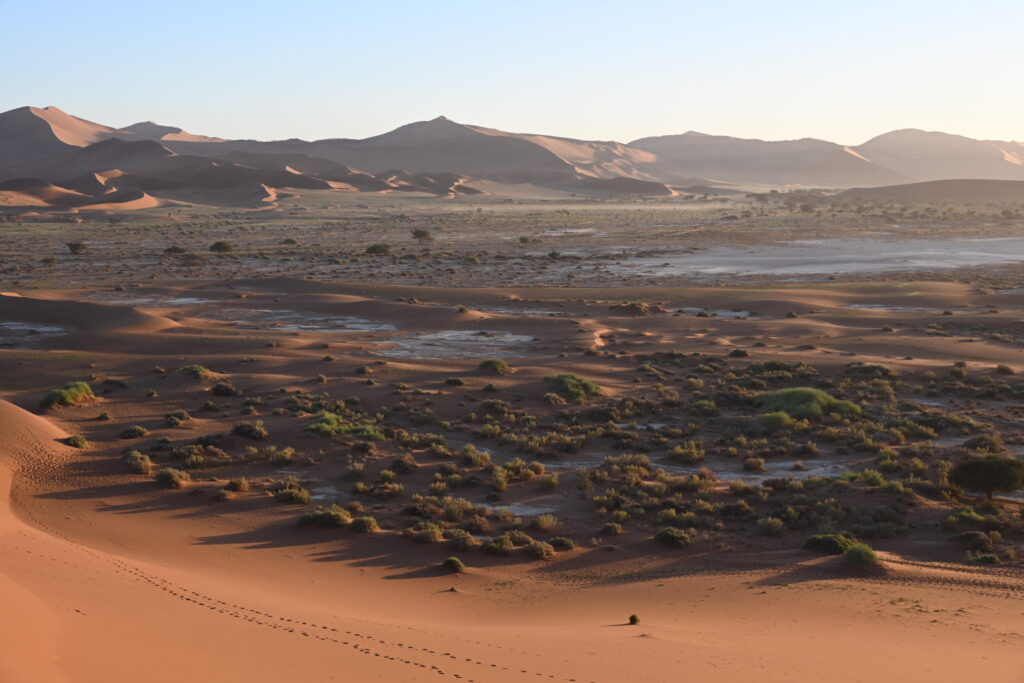
And sure enough, Deadvlei soon comes into view.
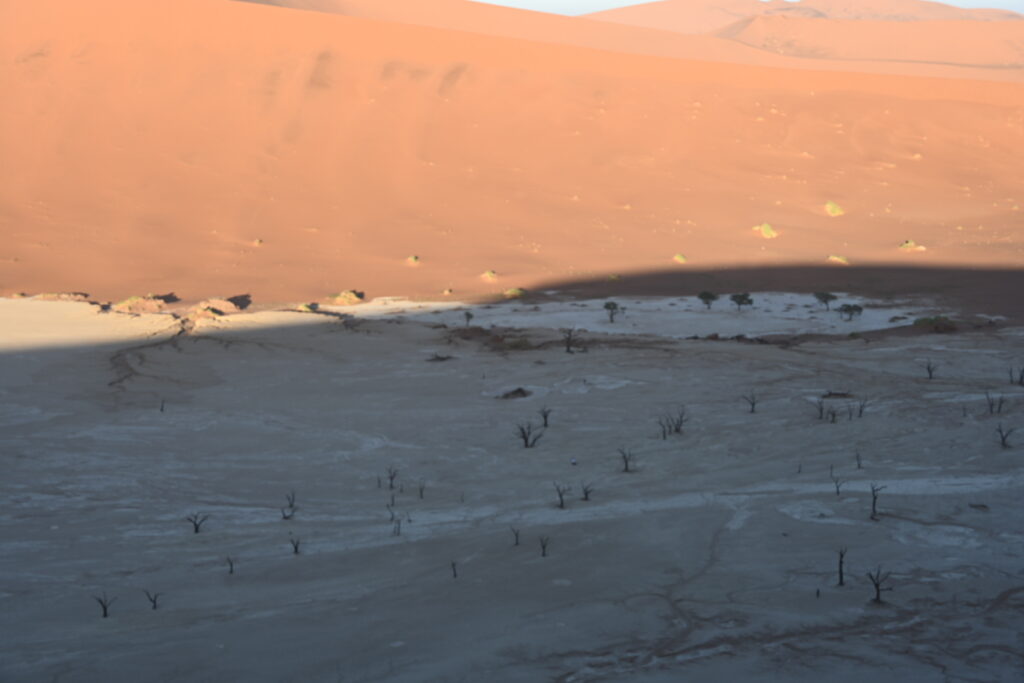
We know where we’re heading. We also spot the devil’s eye, which Ewald was right to warn us about:
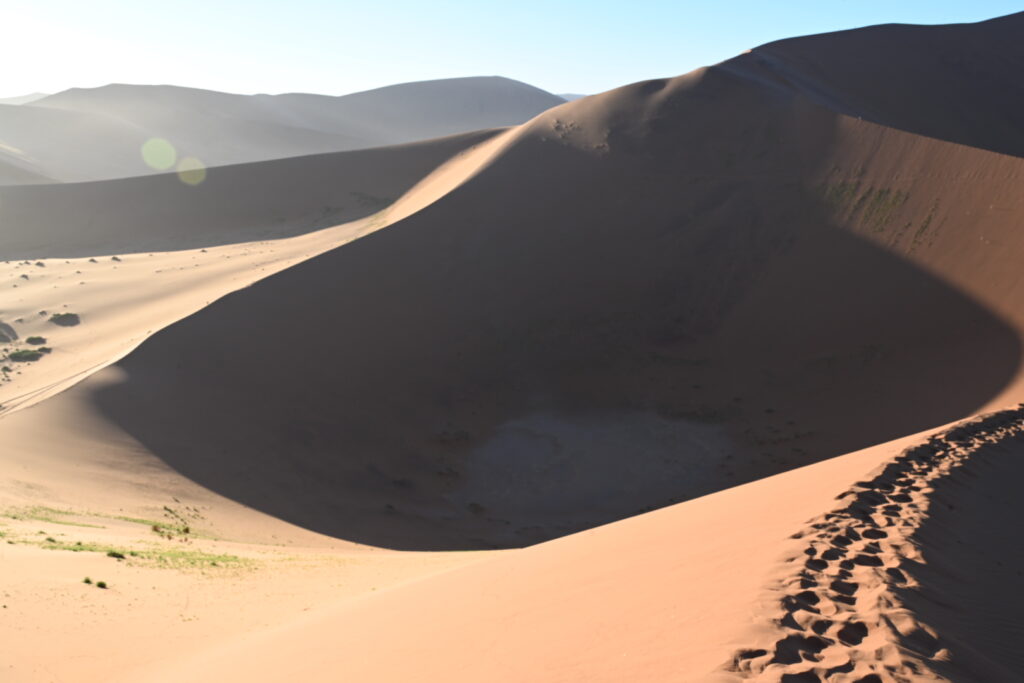
The resemblance is clearer when seen from overhead:

Source: Google Earth
Now that we know where we need to go, we’re free to walk the dune and enjoy the scenery:
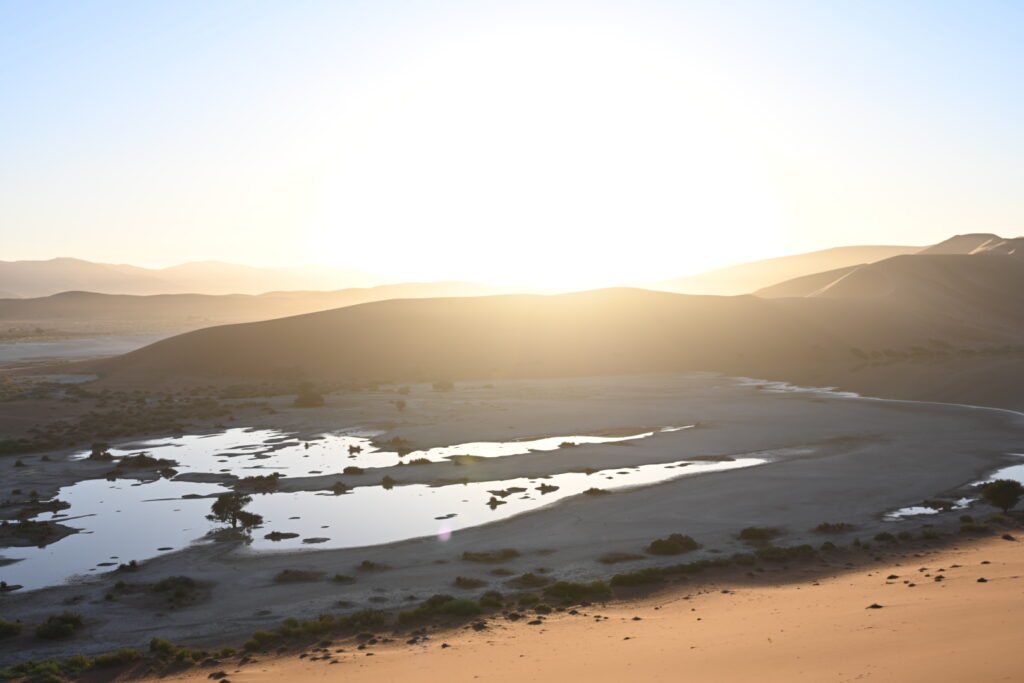
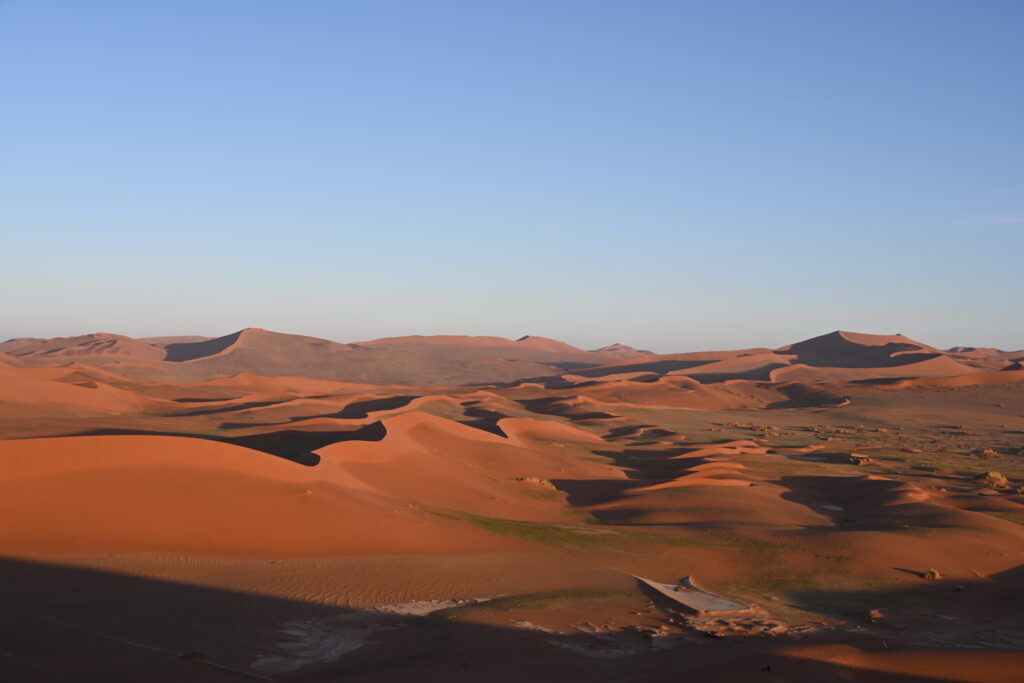
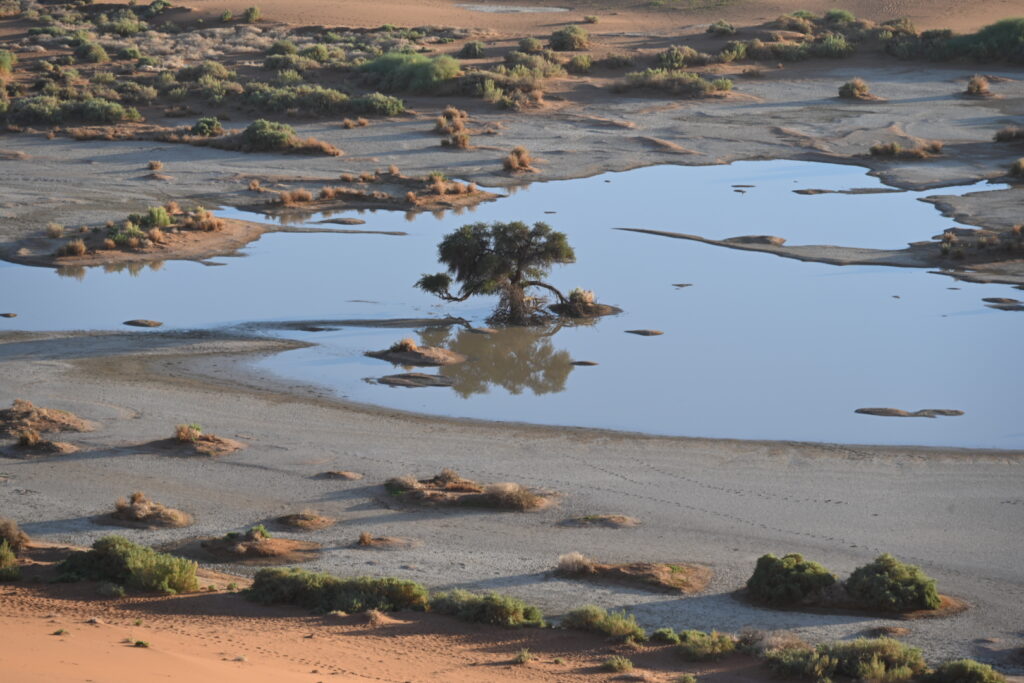
We reach the top of the initial ridge at an elevation of roughly 245 metres. It’s not the peak – Big Daddy is around 325 metres, and Dune 7 near Walvis Bay is over 380 metres – but it’s enough for us.
Though we can’t help but admire those who did make the trek:
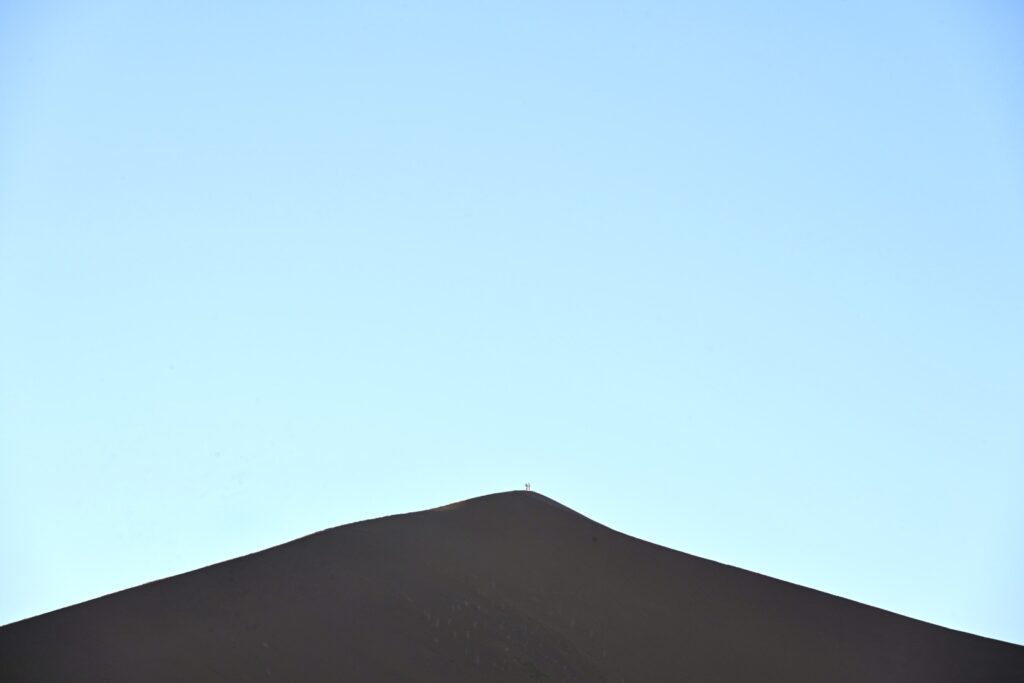
If you can spot the people atop Big Daddy, you do not need glasses
Could we have reached the top of Big Daddy? The sand along the ridge was easier to traverse than we expected, and the morning was cool and pleasant. So I think we would have made it. But I’m still glad we didn’t attempt it, as the penalty for failure would have been high. Even if successful, we would’ve had very little left in the tank.
Having reached our smaller peak, we then descend into Deadvlei.
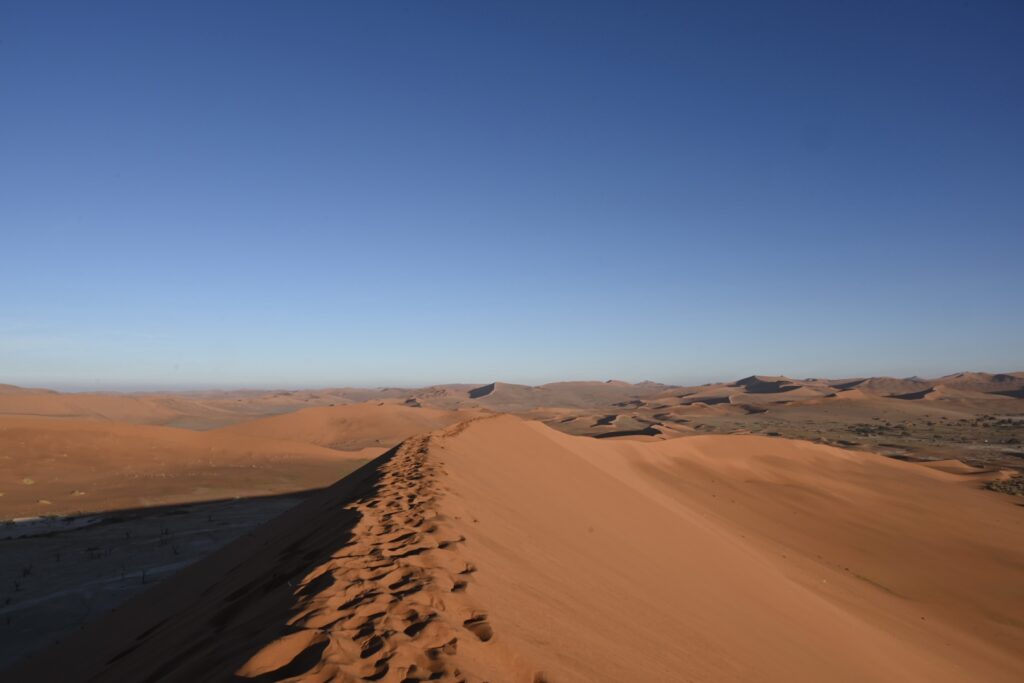
There was once a pool here, but it dried up a thousand years ago. The trees lasted another few hundred years, but they too eventually died and then petrified. It’s a stark and beautiful landscape, particularly with the dunes in the background.
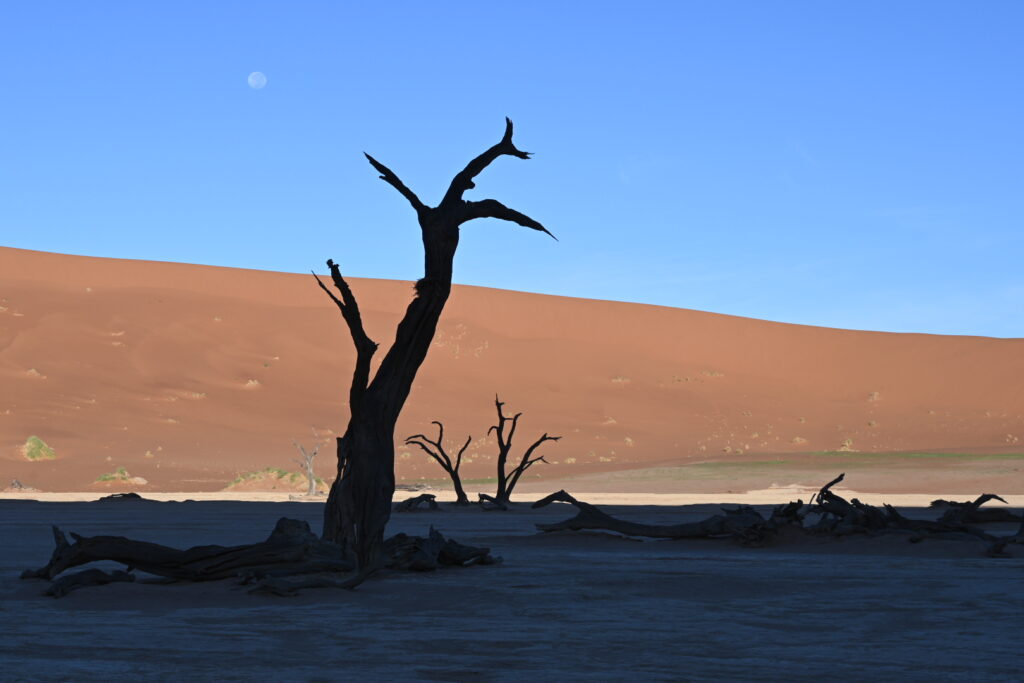
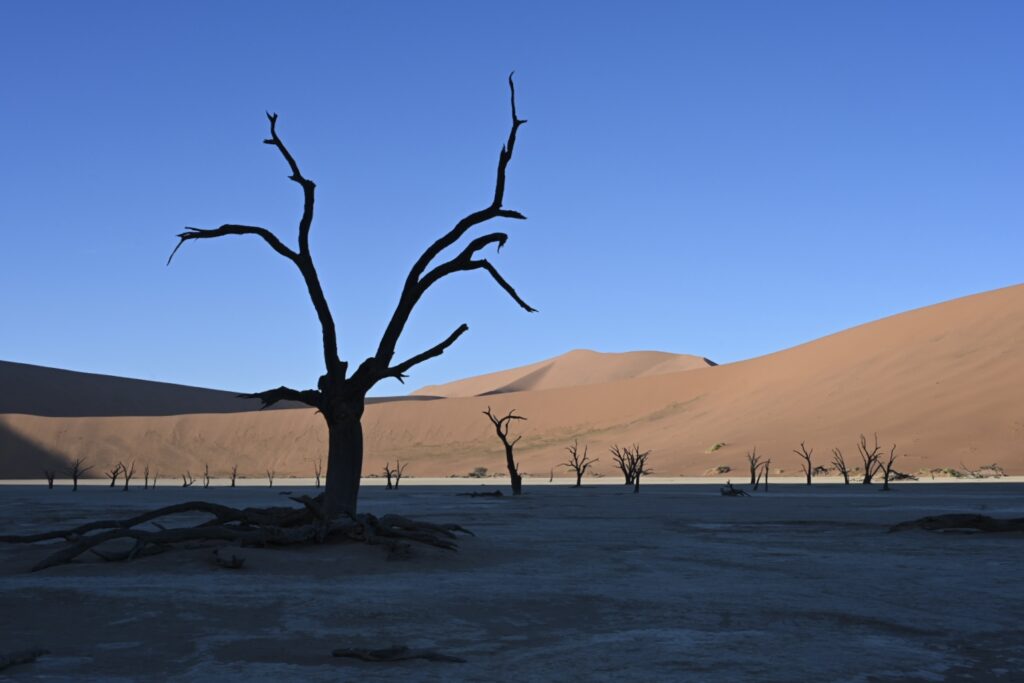
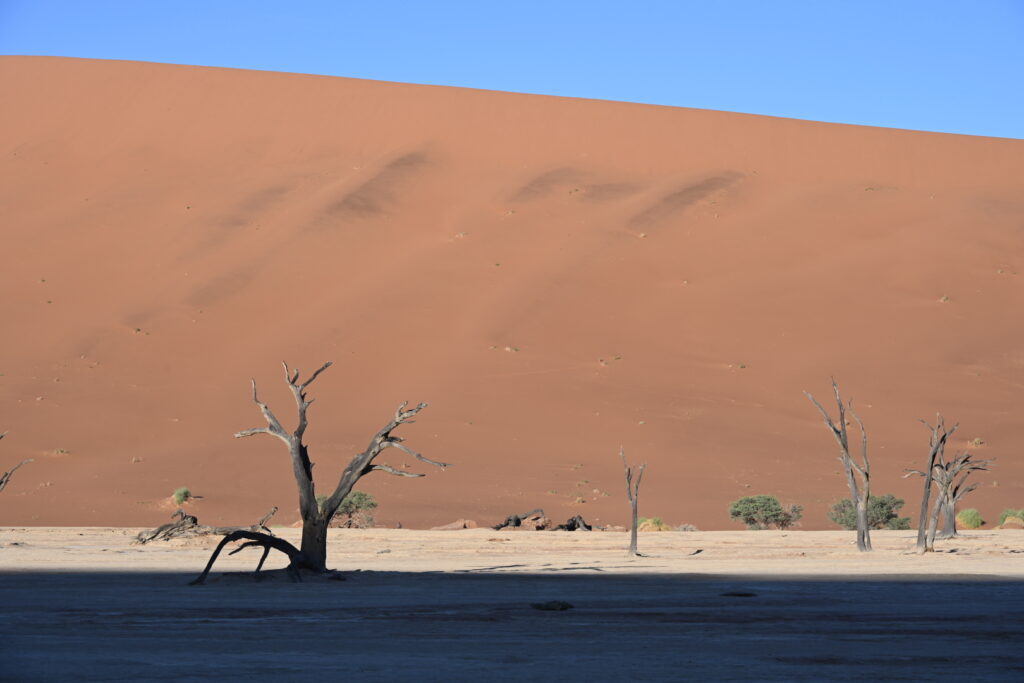
The view up to the dunes is remarkable too:

But even here, there are signs of life – footprints from jackals, and rats, and birds. Ewald shows us a succulent:
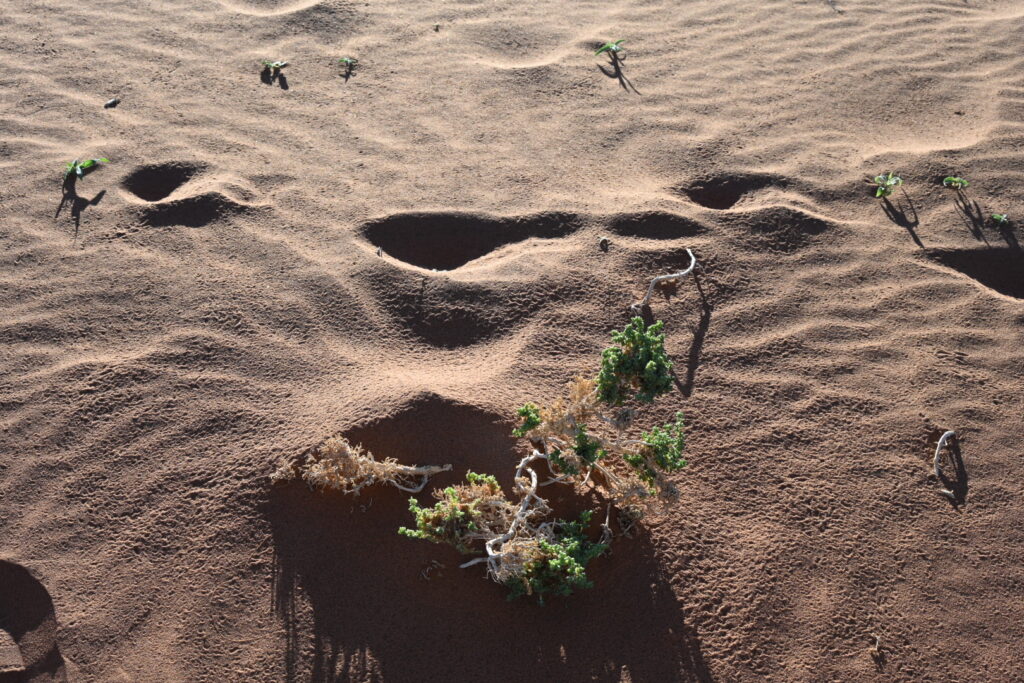
It’s able to survive on mist alone. Water squirts out from between a leaf when he squeezes it. This is one of the reasons that the oryx are able to survive for up to six months at a time without drinking water – they get it from the plants.
And there are still a remarkable number of plants in the area:
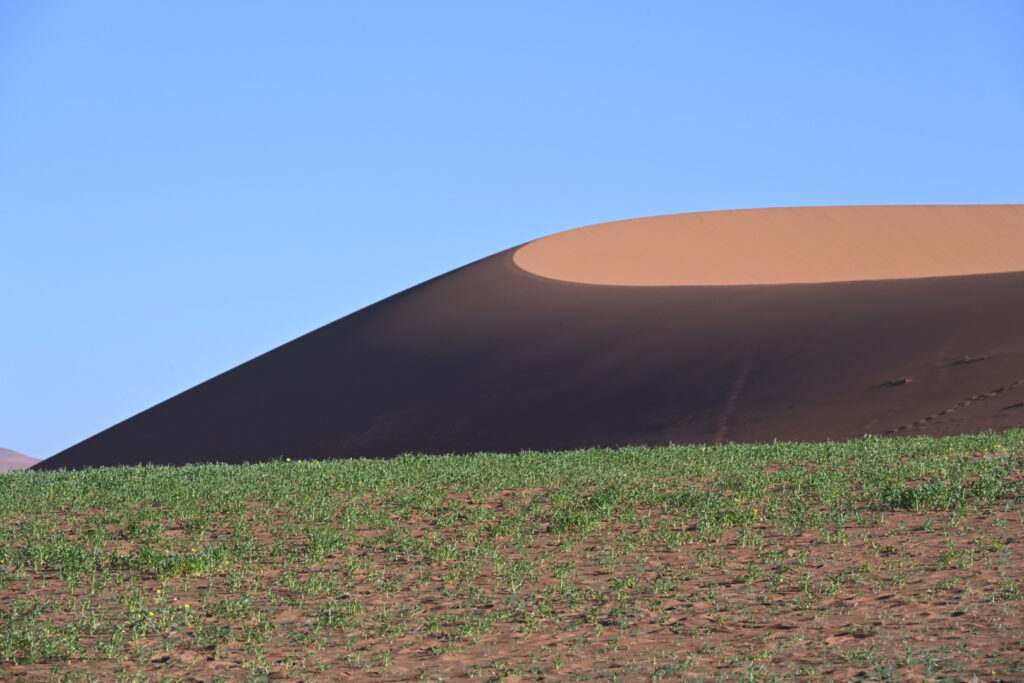

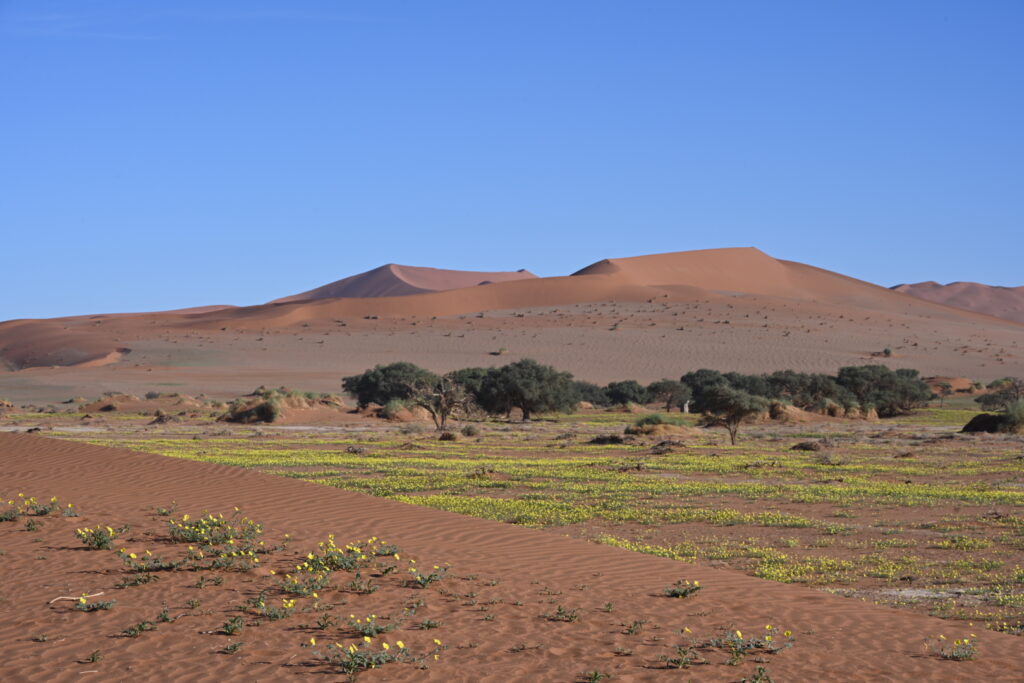
It’s a beautiful time to visit. The rainy season is drawing to an end, but we no longer have the intense heat of summer.
We carry on to Sossusvlei itself, next to another high dune – Big Momma:
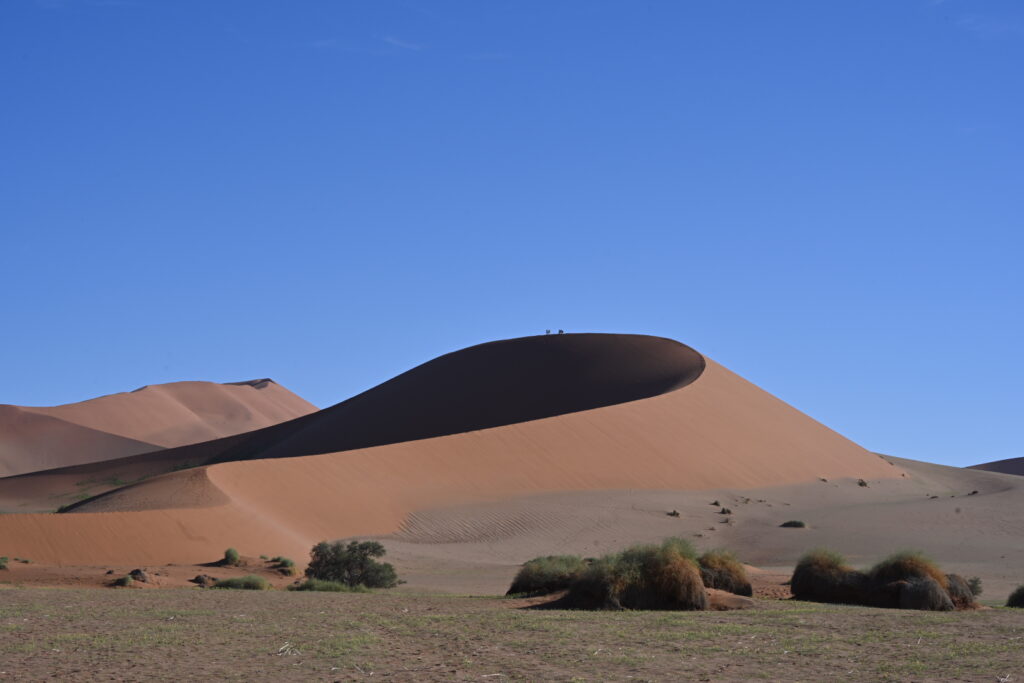
This area previously had a pool of water, but even the recent rains have not been enough to bring it back. Still, the trees seem to be surviving with what moisture lies beneath the surface:


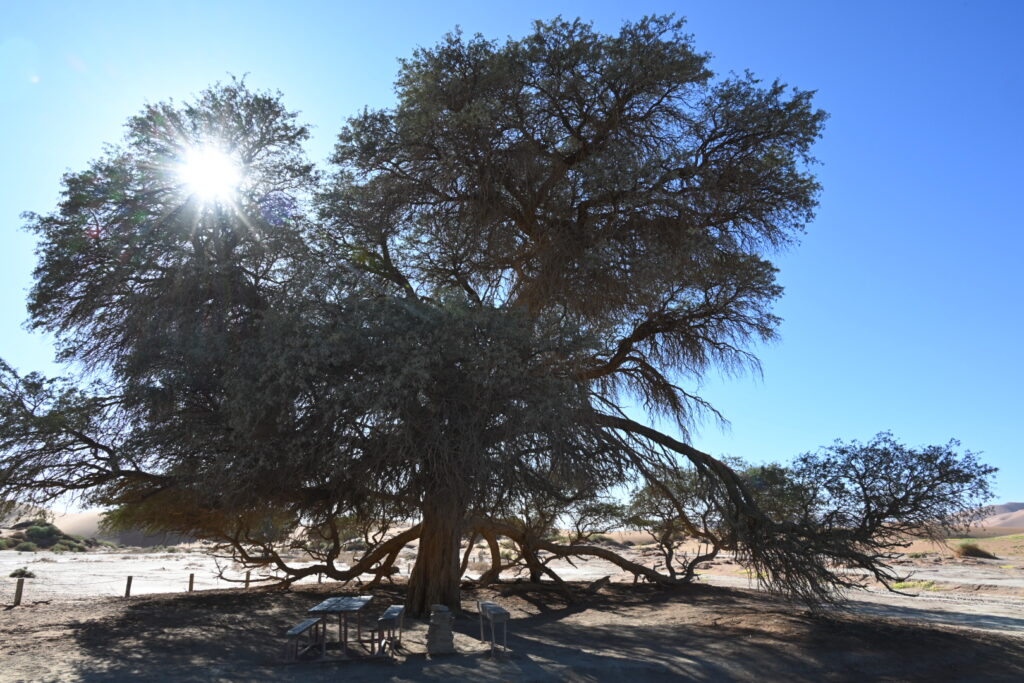
But it makes one wonder whether they too will eventually suffer the same fate as Deadvlei.
Back to the vehicle, and back toward the Lodge. Speaking of oryx, we spot some along the way:


The oryx is the national animal of Namibia. They are beautiful creatures, well adapted to the harsh, dry environment here.
We cross through the gate once more, and then head to Sesreim Canyon:
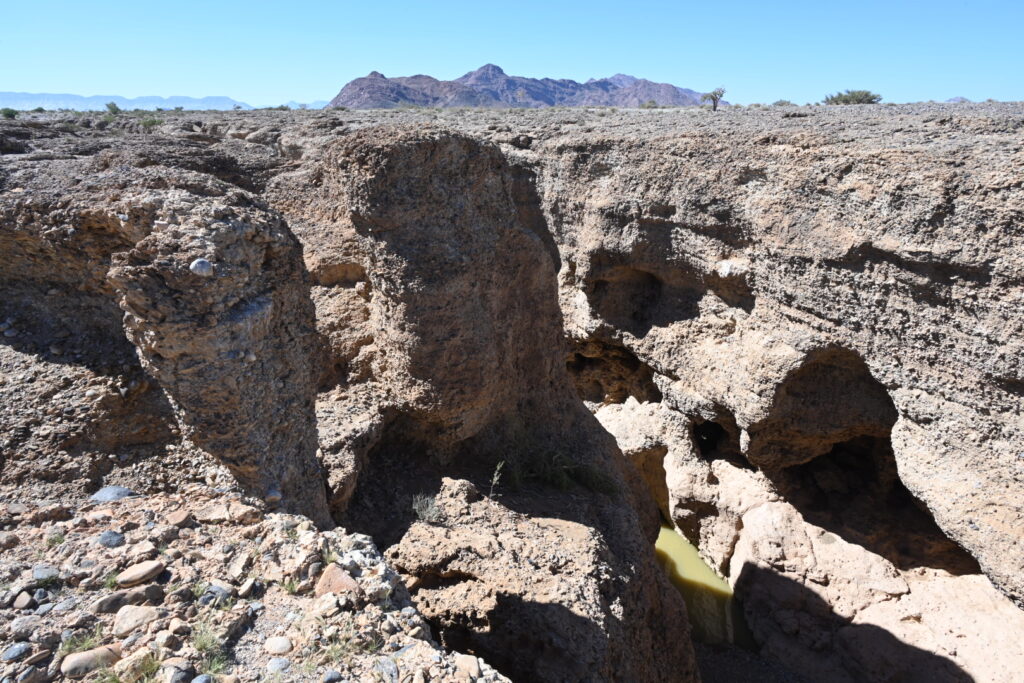
The canyon is named for the number of oryx hides that it took to lower buckets into the canyon to get water – six oryx hides, which would span a length of thirty metres.
The stone here is a kind of conglomerate – a natural cement – into which birds and another wildlife have made their homes. There are swallows and that perpetual survivor – the pigeon:
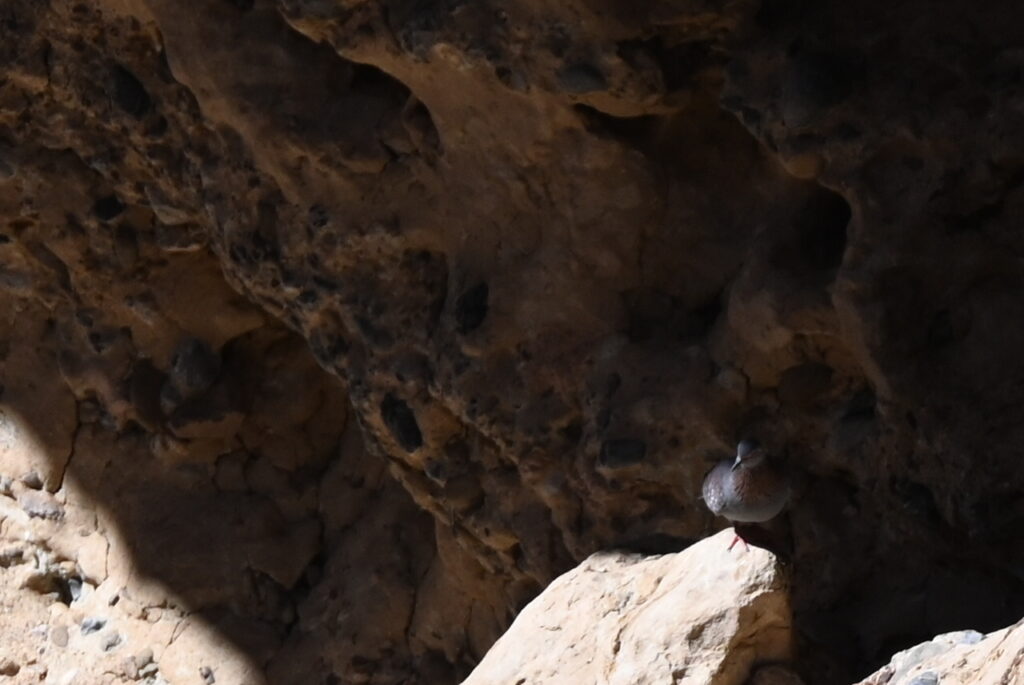
We hike down a trail, and wander into the canyon itself. It’s cool and remarkably quiet.
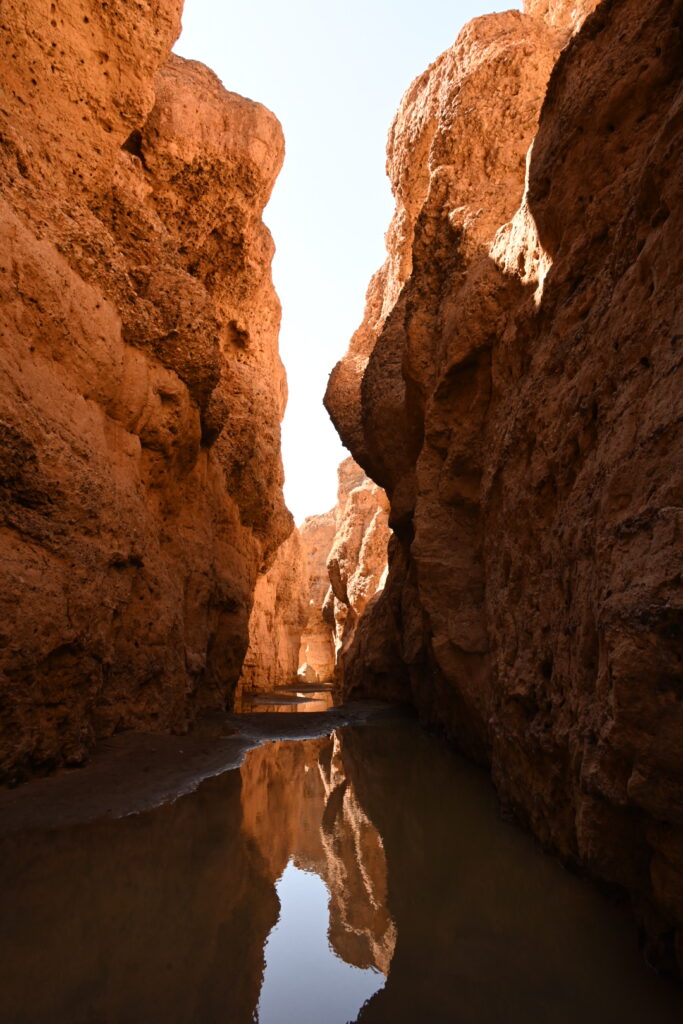
There’s a longer hiking path, but it’s filled with bees so we take that as a sign that we should end our hiking for the day.
It’s around 11:30 am when we return to the Lodge.
And what does that afternoon hold for us? Absolutely nothing, I’m pleased to report. We return to the pool, order some lunch:
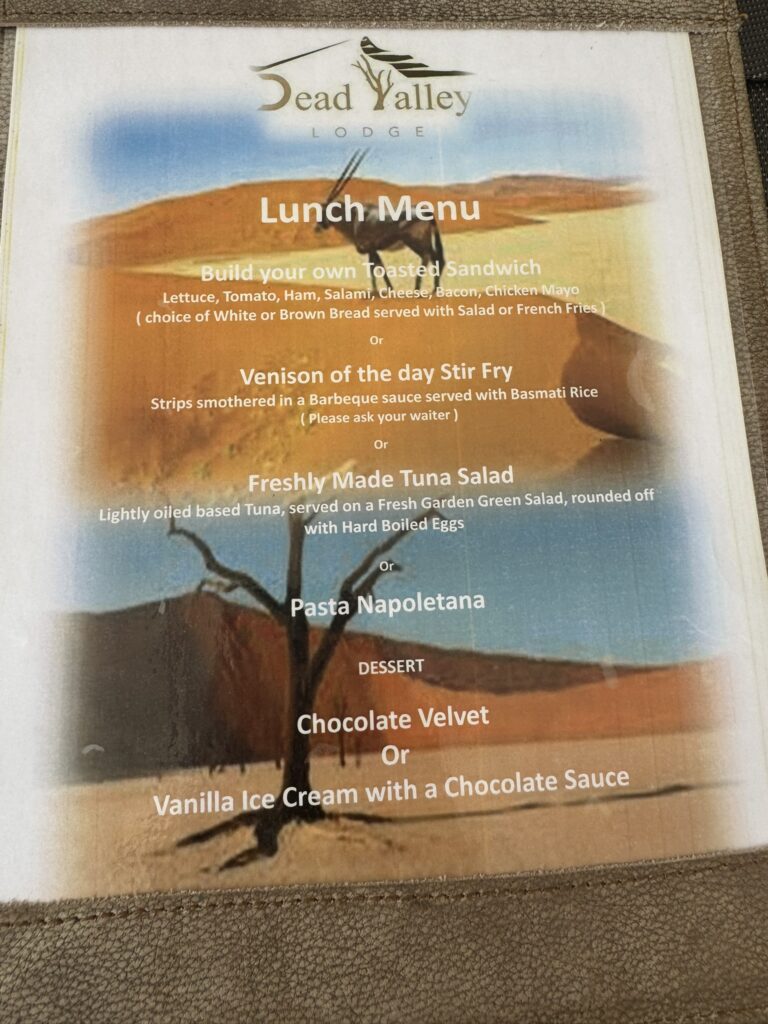
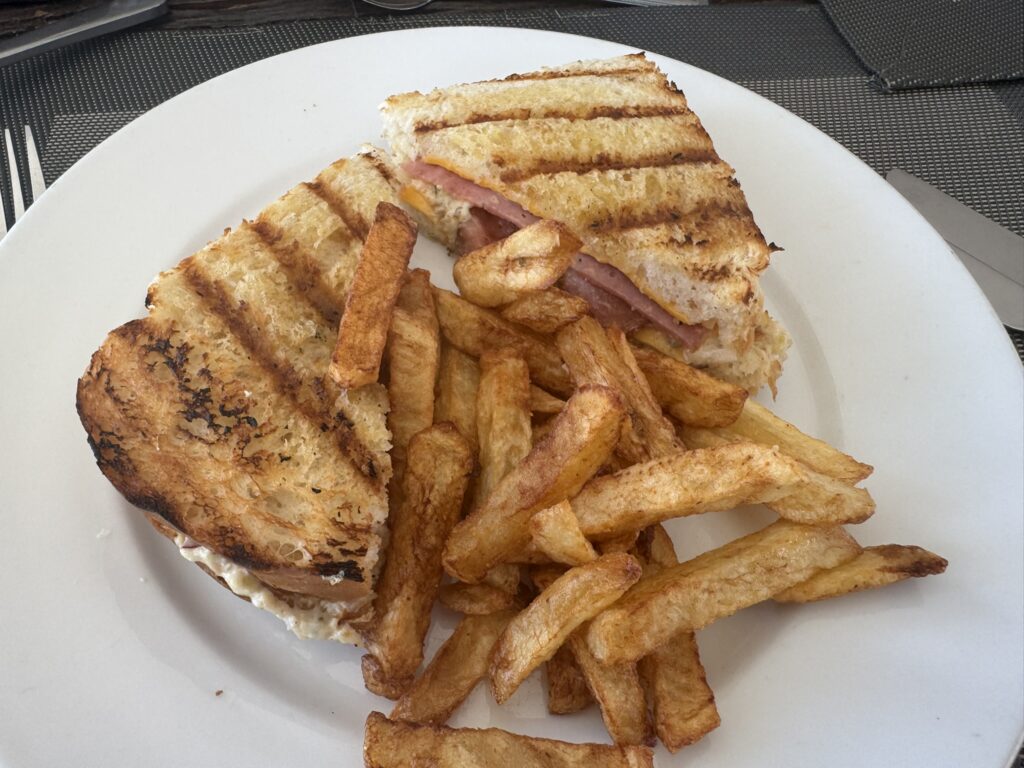
Take a nap, catch up on blogging and homework, and generally take a much-needed break.
It feels like mere moments until sunset arrives:
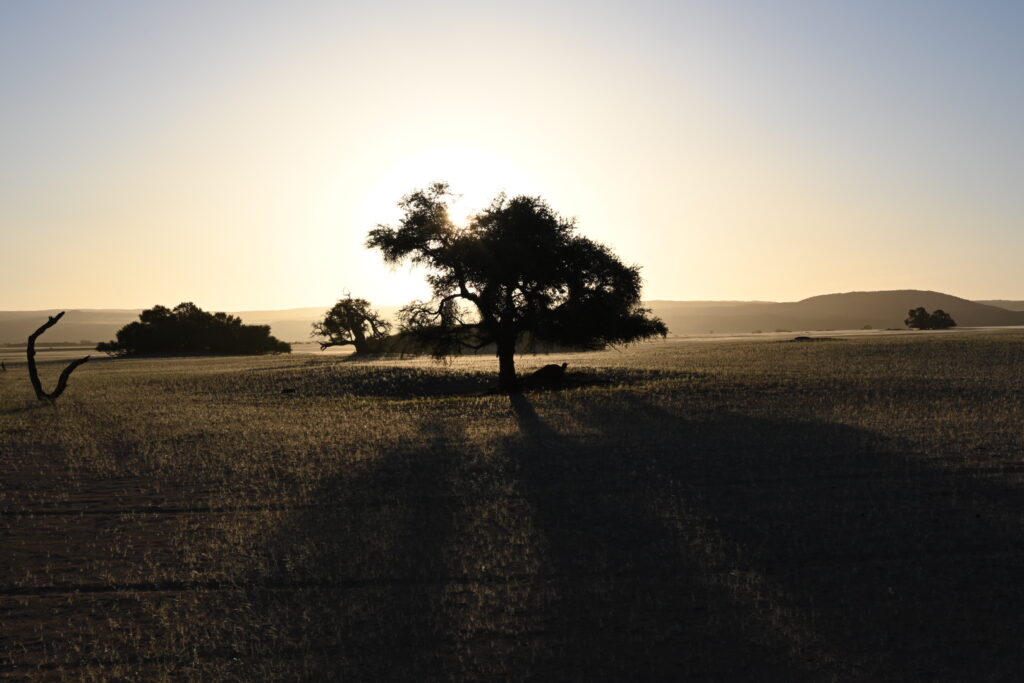
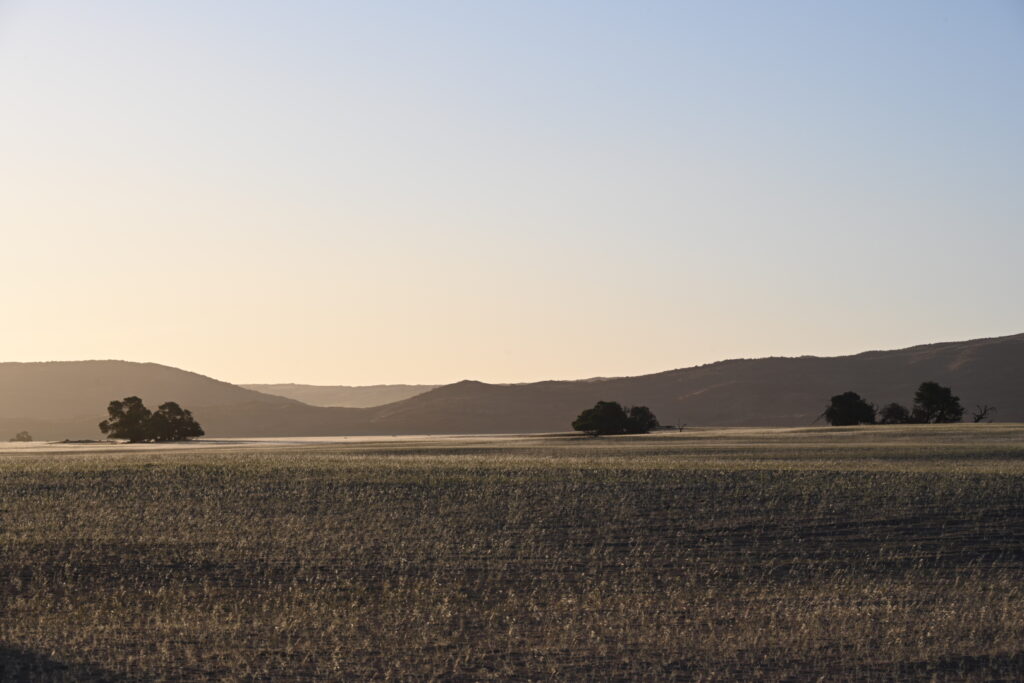

We also get some ‘golden hour’ shots of Dead Valley Lodge, which has been a lovely spot to stay:
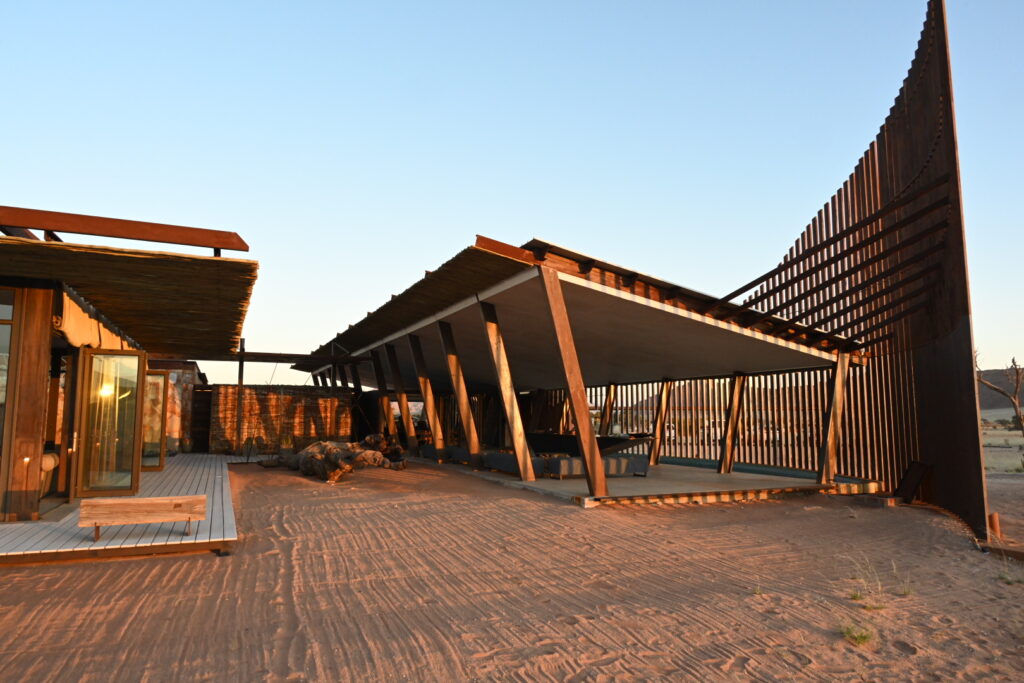
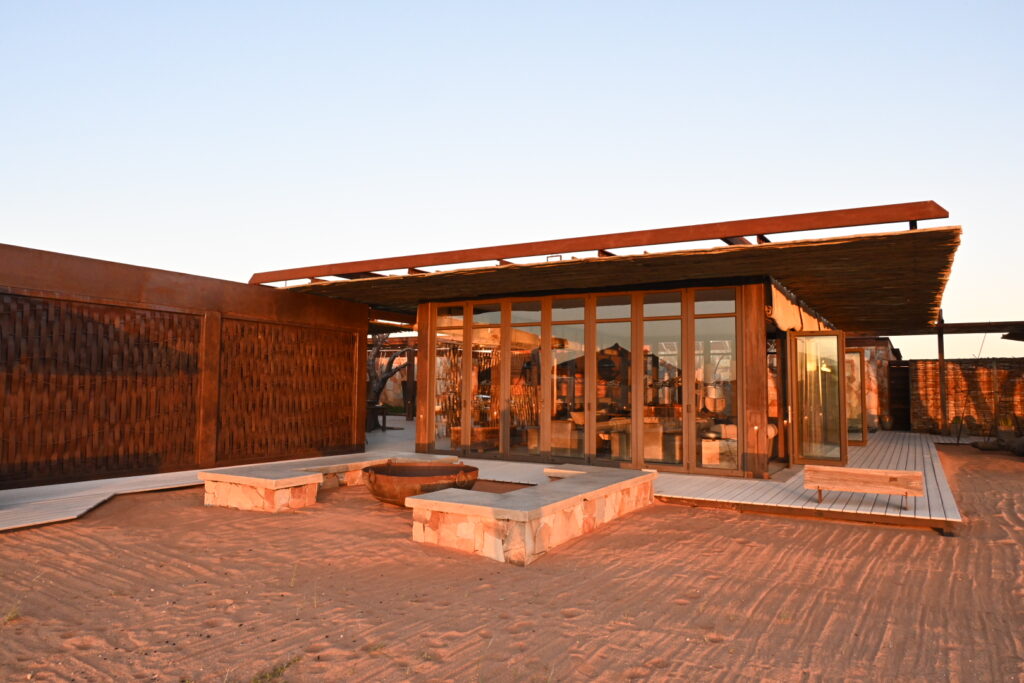
And we pick up our laundry! The prices here were very reasonable, though the laundry bill does need to be paid in cash:
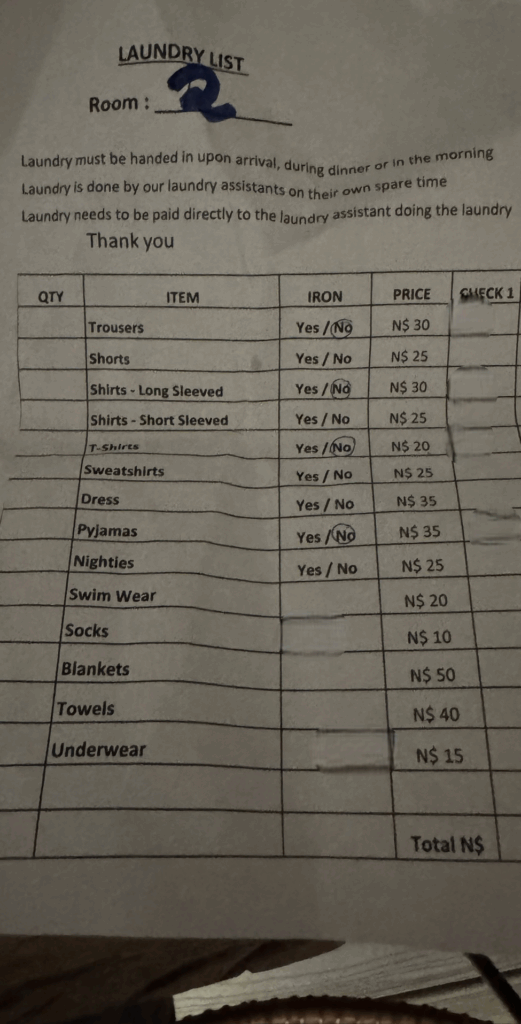
At roughly USD$1 = 20 Namibian dollars, we were able to get all of our laundry done for around USD$40 – a fantastic deal compared to the $5 per sock one often finds at luxury resorts. And no, we didn’t spill water on the receipt – my wife insisted I remove our clothing count from the picture. Fair enough!
They also offer next-day turnaround, which is critical. We’d been worried about doing laundry while on the move here, but so far it hsan’t been an issue.
Walking the laundry back to the room gives me the chance for a few last sunset shots:
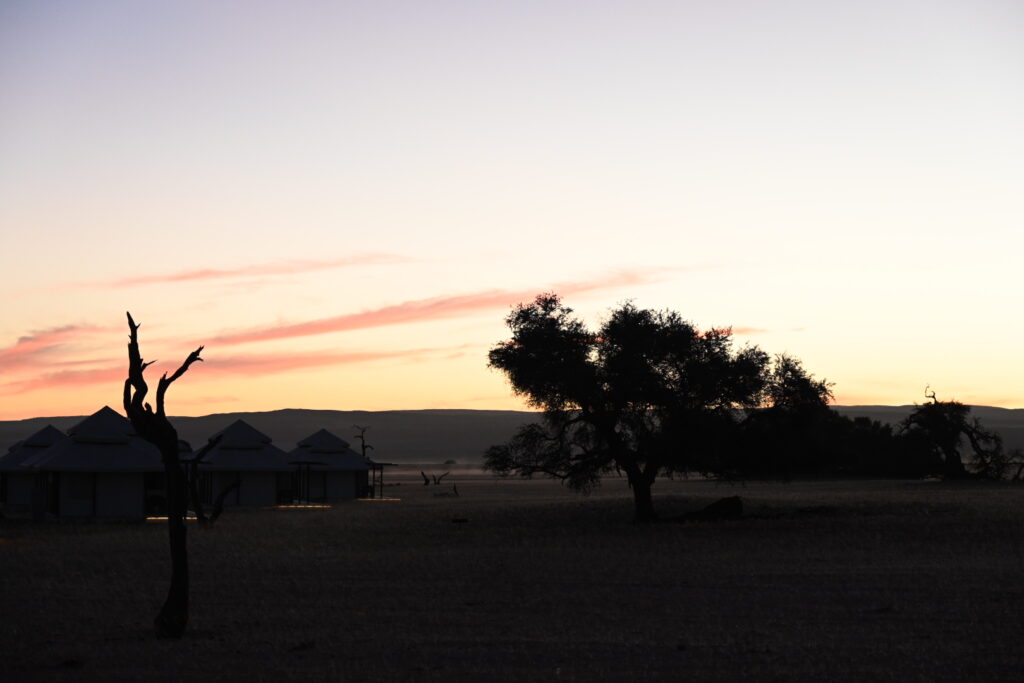
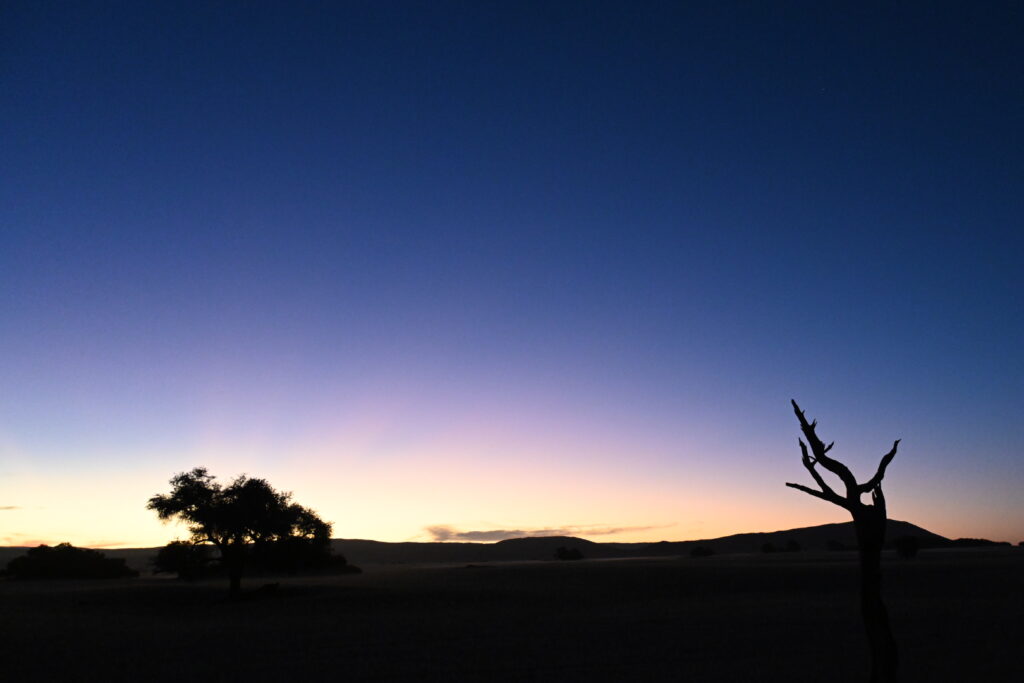
And then dinner, where it’s barbeque again. We run into the same problem as the day before – the meat being profoundly underdone. We get enough to make it work, but there is a lot of wastage.
Even with the break, we are all falling asleep at the table. So we soon retire for the evening – just in time to catch the moon rising over Sossusvlei:
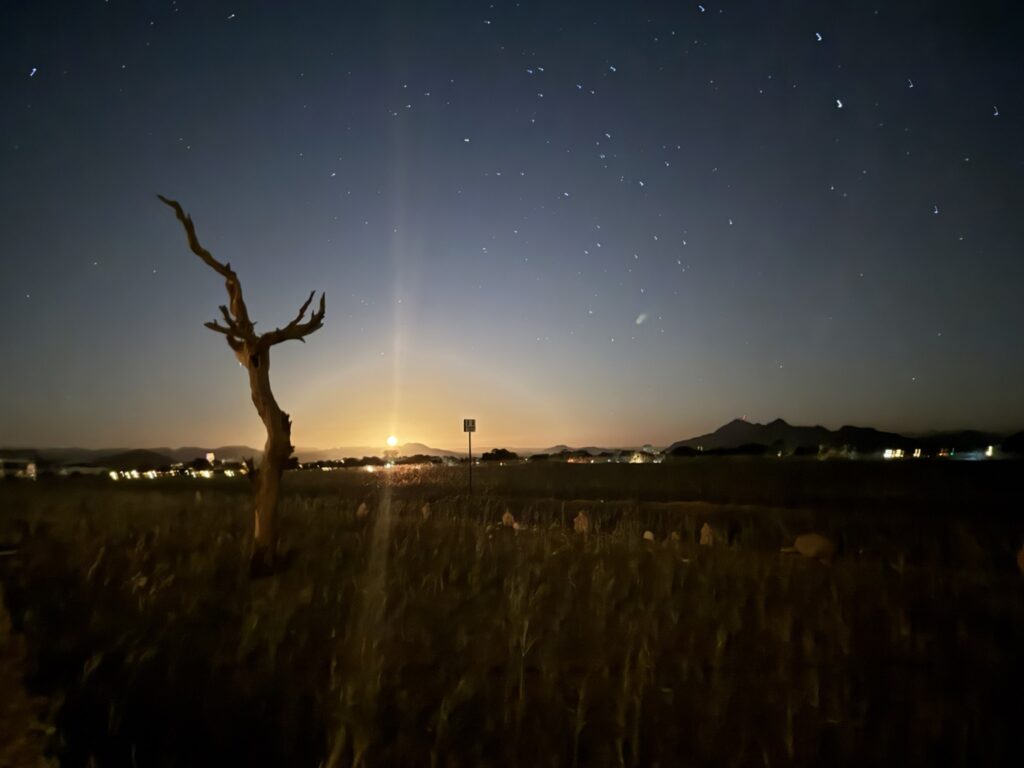
And with the moon low on the horizon, the stars are that much brighter:
But no more time for cosmic photography tonight – the Lodge’s firewall has officially recognized Unknown Longitude as a legitimate website, so I have two posts to get up.
And then – finally – it is time for bed.
Tomorrow we cover more than 300 km to get to Swakopmund, a seaside town near Walvis Bay. Can we arrive at a reasonable hour without having been shaken to pieces? That is the question.
